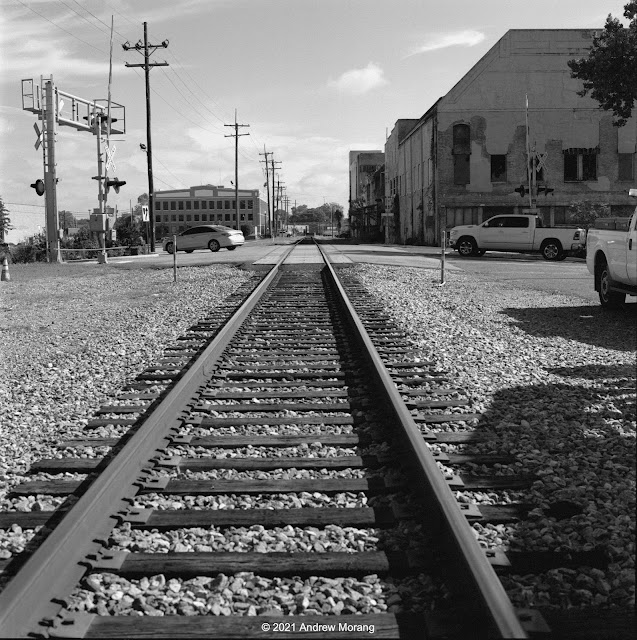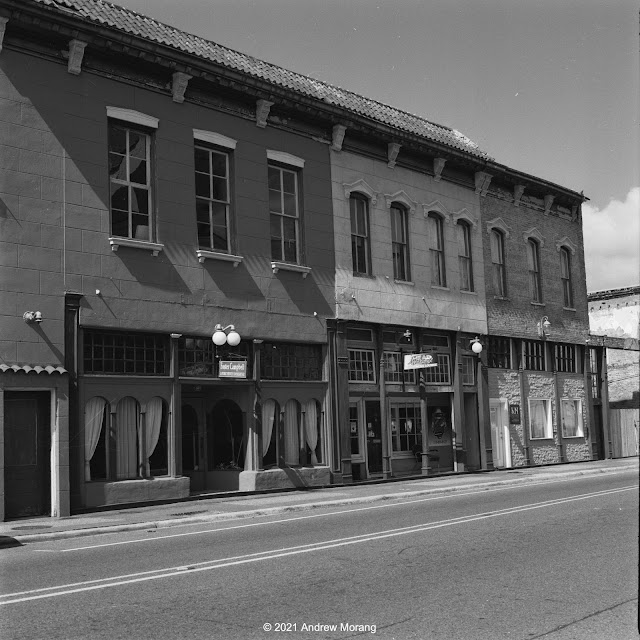 |
| Adolph Rose Building in the center the block (Cooper Post Card Collection, from the Mississippi Department of Archives and History) |
 |
| Clay Street view east with Adolph Rose Building to the left (Fuji X-E1 digital file) |
Adolph Rose Antiques occupied the first two floors of the historic Adolph Rose Building at 717 Clay Street in Vicksburg. This handsome brick structure is one of the finest remaining examples of a multi-floor commercial building of the type that demonstrated Vicksburg's commercial ascendancy and prosperity in the late-1800s.
In 2006, the adjoining building at 515 partly collapsed when some workmen were starting some form of renovation. I wrote about the mess in 2011. No one was hurt, and the damage to the Adolph Rose building was repaired. Now the lot is empty (see the photograph above).
Sadly, Malcolm and Karen sold the Adolph Rose in 2021 and closed their long-running antique store. Before their going-out-of-business sale, they generously let me explore inside with my camera. (Click any picture to expand it and see details.)
 |
| Ground floor of Adolph Rose Antiques (Fuji X-E1 digital file) |
 |
| Rear (north side) of ground floor (Kodak Panatomic-X film, Leica M2 camera) |
The street-level (ground) floor occupied half of the structure. On the other side of the long wall is the Strand Theatre. The Strand is active and is a venue for independent films and live productions from the Westside Theatre Foundation. The building was remodeled to include the Strand in 1934, and the cinema was active for decades.
Scales, cookware, a wringer-clothes washer, James Dean's toilet - it was all available here. I did not check if the old tube radios worked.
Old-fashioned shoe lasts to prevent leather shoes from curling when stored in the closet. How many of you readers have used shoe lasts? They really do prolong the life of shoes, cowboy boots, and hiking boots.
The glassware was backlit near the back wall. Nice display.
Sturdy stairs lead up to the second floor. Up here, the antiques occupy the entire width of the building. This was a nice, airy space.
Books and LP records were on the second floor. None of the LPs interested me as they were rather romantic or schmaltzy 1960s offerings, but there likely is a market.
This ends our brief exploration of the Adolph Rose Antiques.
Several apartments are on the floors above, but they had tenants and were off limits. I do not know if the new owners of the Adolph Rose will continue to rent the apartments.
I wrote about a similar treasure/antique store on Halls Ferry Road in 2013. Sadly, that store closed in 2014 and all the neat items disappeared somewhere.
I took most of these 2020 photographs on 35mm Kodak Panatomic-X film using my Leica M2 camera with 35mm or 50mm ƒ/2 Summicron lenses. Panatomic-X is a slow film, but that is what was loaded in my camera. This was one of my three last rolls and was in good condition. The light was a mixture of side-lighting from the tall windows along with tungsten and halogen bulbs overhead. I bounced flash off the ceiling, but it was so far above the furniture, I suspect there was minimal extra fill. Most were 1 sec. exposures, tripod-mounted. The traditional Panatomic worked well for this type of subject matter with just the right graininess (please click any frame to see more details). All comments welcome. Please see earlier articles dealing with other abandoned (discontinued) films.

































